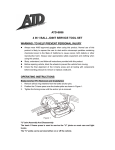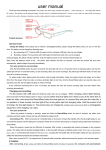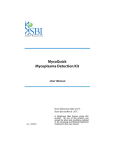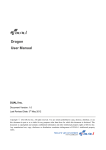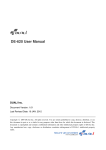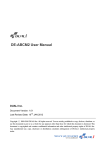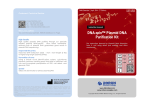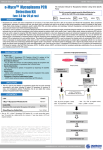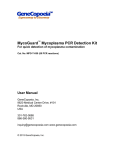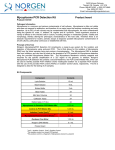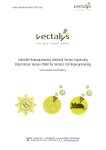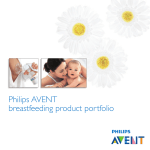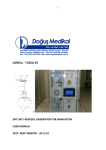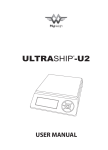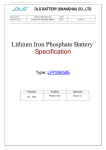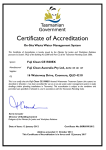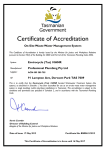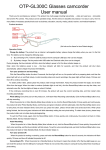Download e-Myco VALiD-Q User Manual
Transcript
qPCR – MD instructions │ MAY, 2015 (1st Edition) ISO 9001 / 14001 / 13485 Certified Company Test for the detection of Mycoplasma by qPCR analysis e-Myco™ VALiD-Q -15ºC Mycoplasma qPCR Detection Kit RUO BACKGROUND INFORMATION PRINCIPLES • The real-time qPCR(quantitative polymerase chain reaction) DNA amplification technology shows high sensitivity and specificity for direct detection of pathogen (antigen). iNtRON developed a novel platform technique about primer design called CLP™ (complementary locking primer) technology which provides flexibility in Tm (melting temperature) of primer design for optimization of reaction condition, and maximizes PCR specificity and sensitivity through the control of non-specific priming. • The kit contains all reagents required for real-time polymerase chain reaction: nucleotides, primer and probes, reaction buffer, polymerase and controls. After rehydration of the components the PCR Master mix is easily prepared by just adding the Inhibition Control DNA and Taq DNA polymerase to the Primer & Probes. • The PCR is initiated with a 5 minute high-temperature step to melt all nucleic acids and to activate the polymerase. In a successful PCR, the presence of mycoplasmas will be indicated by a signal in the FAM channel. Contents 50 -25ºC Storage Amount 2X qPCR Master Mix Solution -25 ~ -15ºC 500 μl x 1 vial (10 μl / test × 50 tests) Mycoplasma Detection Solution -25 ~ -15ºC 250 μl x 1 vial Positive Control (External PC) -25 ~ -15ºC 25 μl x 1 vial DNase/RNase Free Water - 250 μl x 1 vial Manual - 1 ea NOTICE • To prevent contamination of mycoplasma DNA during experimental procedure, always wear gloves during sample preparation and PCR reaction setup. • To avoid false positives, water used in PCR reactions can be UV-irradiated. • If no internal positive control signal, it shows the problem during PCR process. Please re-test. • If there is non-specific signal in negative control, it could be due to the contamination or overused template. Please re-test with proper amount of template. SHELF-LIFE • 12 months from manufacturing date. • Within 3 months after opening, within expiry date of the kit. KIT WORKFLOW Cultivated Cell KIT CONTENTS 2X qPCR Master Mix Solution Σ Prototype PACKAGING INFORMATION AND STORAGE Mycoplasmas are small, round or filamentous prokaryotic organisms which are a frequent contaminant of cell cultures. Mycoplasma depend on their hosts for many nutrients due to their limited biosynthetic capabilities. Up to 30~85% of cell cultures may be contaminated with mycoplasmas, the main contaminants being the species M.orale, A.laidlawii, M.arginini and M.hyorhinis. Although these mycoplasmas do not usually kill contaminated cells, they are difficult to detect and can cause a variety of effects on cultured cells, including changes in metabolism growth, viability and morphology, there by altering the phenotypic properties of the host cells. Many methods are available for detection of mycoplasma, including isolation in broth/agar culture, direct or indirect fluorescence staining, ELISA, immunostaining, direct or indirect PCR. Among those methods, direct PCR is the highly sensitive, specific and convenient method when the primer design is optimized. The e-Myco™ VALiD-Q Mycoplasma qPCR Detection Kit is composed of a set of primers and probe that are specific for the highly conserved mycoplasma16S-rRNA coding region including M.pneumoniae, M.argnini, M.hyorhinis, M.fermentans, M.orale and A.laidlawii. The kit is designed to detect the presence of mycoplasma that might contaminate biological materials such as cultured cells. Also, the kit can detect mycoplasma within 90minutes sensitively up to 10CFU/ml and includes internal control for verifying a qPCR run as well as positive control DNA. Contents REF PROTOCOL A PROTOCOL B Cell boiling method Genomic DNA method Composition Cell harvest & washing • Real-time PCR Reaction solution < 0.01% dATP, dTTP, dGTP, dCTP < 0.01% Hot start PCR enzyme < 0.01% PCR additive materials • Mycoplasma Detection solution Detection Solution DNase/RNase Free Water < 0.001% Primer /probe for Mycoplasma < 0.001% Internal control primer pair < 0.001% Internal control DNA Boiling (95ºC, 10min) • Ultrapure sterilized distilled water DNA purification using G-spin Total DNA Extraction Kit(Cat. No. 17046) positive control Positive Control (External PC) • Mycoplasma < 0.001 % Recombinant DNA contained 16S sequence of M. hyorhinis Instruction Manual Crude lysate (Supernatant) Purified DNA STORAGE AND STABILTY • Storage condition: Store the product at -25~-15ºC after receiving. • Expiration: e-Myco™VALiD-Q Mycoplasma PCR Detection Kit can be stored for up to 12 months without showing any reduction in performance and quality under appropriates or age condition. The expiration date is labeled on the product box. APPLICATION The kit is used for the detection of mycoplasma species that are most commonly encountered in cell culture, including M.peumoniae, M.arginini, M.fermentans, M.hyorhinis, M.orale, and A. laidlawii. Furthermore, this kit can detect other various species of mycoplasma. Perform Real time PCR 10μl 5μl 2X qPCR Master Mix Detection Solution 5μl Template Step Pre-denaturation PCR and Signal Detection MATERIALS REQUIRED BUT NOT PROVIDED • • • • Realtime PCR Instrument Pipettes Centrifuge for micro-centrifuge tubes Disposable gloves IBT-QMS-Prototype • G-spin total Extraction Kit (Cat. 17045) • Sterile pipette tip (with filter) • Vortex mixer 1/2 Analyze the results [email protected] www.intronbio.com www.intron-innoplex.com PCR tube (optic grade) Cycle Temp 1 40 Time Channel setting 95 ºC 5’ 30” Mycoplasma FAM 95 ºC 15” IPC HEX 58 ºC 1’ qPCR – MD instructions │ MAY, 2015 (1st Edition) ISO 9001 / 14001 / 13485 Certified Company PROTOCOL DATA VALIDATION You can use this protocol just for detecting the contamination of mycoplasma. However, if you want to perform genotyping for the detailed determination of species, please purify the genomic DNA of suspected Mycoplasma-infected cells using our G-spin Total DNA Extraction Kit (Cat.No.17046). You may use simply this protocol or your other general boiling methods. [ TECHNICAL TIP ] 1. Use clean, disposable gloves when performing the assay and make sure that the work area is clean prior to starting the assay setup. 2. Keep your reagents and PCR mixture tubes on a cold block during reaction setup. 3. Use positive displacement pipettes. 4. The amplification and detection areas should be physically separated; i.e., do not use the same bench area to set up the PCR reactions and run your gels. 1. When the reaction is finished, put a cut-off value according to the below table. Set Manual baseline Threshold Ct Cutoff Value 3 ~15 Auto Drop after 36 cycle 2. Valid Results : Ct value of control should be as below table Items FAM HEX Items FAM HEX Positive Control 18 ~ 22 22 ~ 25 Negative Control <36 <36 DATA INTERPRETATION PROTOCOL A : Using the Boiling Extract Method 1. Expected Real-time RT-PCR Data 1. Prepare cell suspensions from the test cell culture in a 1.5 ml tube. Then count cell numbers by general counting methods. You need at least 5x104 cells per test. Note 1: Harvest adherent cells with trypsin-EDTA solution using standard techniques. Pipette 1 ml of TE-treated adherent cells. Generally, with suspension cells, such as K562, you need not treat with TE solution. We recommend that you count the cells. You should prepare at least 5x104 cells per test. Note 2: Strong mycoplasma infections are detected in as little as 10~100 cells, while weak infections require cells over 5,000~50,000 cells. You can dilute the template according to the infection rates you suspect Positive control Mycoplasma (FAM) + IPC (HEX) + 2 Negative control - + Valid 3 Test 1 + + Positive 4 Test 2 + - Positive (High concentration of Mycoplasma DNA) Negative (Mycoplasma Free) No. Samples 1 Interpretation Valid 2. Transfer the counted cells (over 5x104 cells) to a 1.5 ml tube. Spin the tube in a microcentrifuge for 10~15 seconds. Carefully decant the supernatant. 5 Test 3 - + 6 Positive Control - + Retest 3. Resuspend the cells in 1 ml of sterile PBS or DPBS solution for washing. 7 Negative Control + + Contamination 4. Spin the tube in a microcentrifuge for 10~15 seconds. Carefully decant the supernatant. Note : [Option] Repeat this wash step once more. 5. Resuspend the cell pellets in 100 μl of sterile PBS or DPBS solution. Note : If you want the best result, use of PBS solution is better than Tris (10 mM, pH 8.5), TE (10 mM Tris, 0.1 mM EDTA), or autoclaved DW. 6. Heat the samples at 95 ºC for 10 min, and vortex for 5-10 sec. Then, centrifuge for 2 min at 13,000 rpm with a tabletop centrifuge (at RT). EXPLANATION OF SYMBOLS LOT Σ Batch number Components 10 μl Mycoplasma Detection Solution 5 μl Total volume 15 μl 10. After centrifugation, put them into a real-time PCR system and process reaction. Channel setting Step Cycle Temp Time Pre-denaturation 1 95 ºC 5’ 30” Mycoplasma FAM 95 ºC 15” IPC HEX 58 ºC 1’ PCR and Signal Detection 40 Observation Possible Cause Recommendation Incorrect dye components chosen Reaction component omitted Check that all the correct reagents were added Degraded template or no template added Repeat with fresh template Reaction inhibitor present Repeat with purified template ΔRn ≤ No Template control ΔRn, and both reaction show an amplification plot Template contamination of reagents Check technique and equipment to confine contamination. Use fresh reagents Amplification plot dips downwards Ct Value less than 15, amplification signal detected too early Reset the upper/lower value of baseline (two cycles lower than Ct Value). or repeat with diluted sample Amplification plots is not within the log phase PCR efficiency is poor Re-optimization the reaction conditions Less template added than expected Increase sample amount Sample is degraded Evaluate sample integrity More template added than expected Reduce sample amount Template contamination of reagents Check technique and equipment to confine contamination. Use fresh reagents. Repeat with aerosol barrier pipette tip after space cleaning Ct value is lower than expected PROTOCOL B : Using genomic DNA as a template Expire date Check dye component prior to data analysis Ct value is higher than expected * Under line means signal detection step Product number TROUBLESHOOTING GUIDE ΔRn ≤ No Template control ΔRn, and no amplification plot 9. Fill up with the supernatant 5μl and Master Solution 15μl in the PCR tube. Note 1 : For Negative Control : 5μl DNase / RNase Free Water Note 2 : For Positive Control : 5μl Positive Control REF Storage temperature limitation Manufacturing date Master Solution (per test) 2X qPCR Master Mix Solution for research use only 50 Sufficient for 50 tests 7. Transfer an aliquot of the heated supernatant to a fresh tube. This supernatant will be used as the template in the PCR. 8. Prepare Detection Mix by dispensing components to each real-time PCR tube in the following manner RUO Repeat with aerosol barrier pipette tip after space cleaning 1. Add 5μl of purified genomic DNA as a template using the G-spin Total DNA Extraction Kit (Cat. No. 17046), and then resuspend after adding Master Solution 15μl in the PCR tube. Note : Appropriate amounts of DNA template sample: genomic DNA, 50 ng–100 ng 2. Follow protocol A from step 10. Note: Recommend to perform one negative control reaction by adding 5μl of sterile water. We recommend to add 5μl of control DNA for positive control reaction. Technical advice : +82-505-550-5600 Review date : 2015. 5. 6. IBT-QMS-Prototype 2/2 [email protected] www.intronbio.com www.intron-innoplex.com


